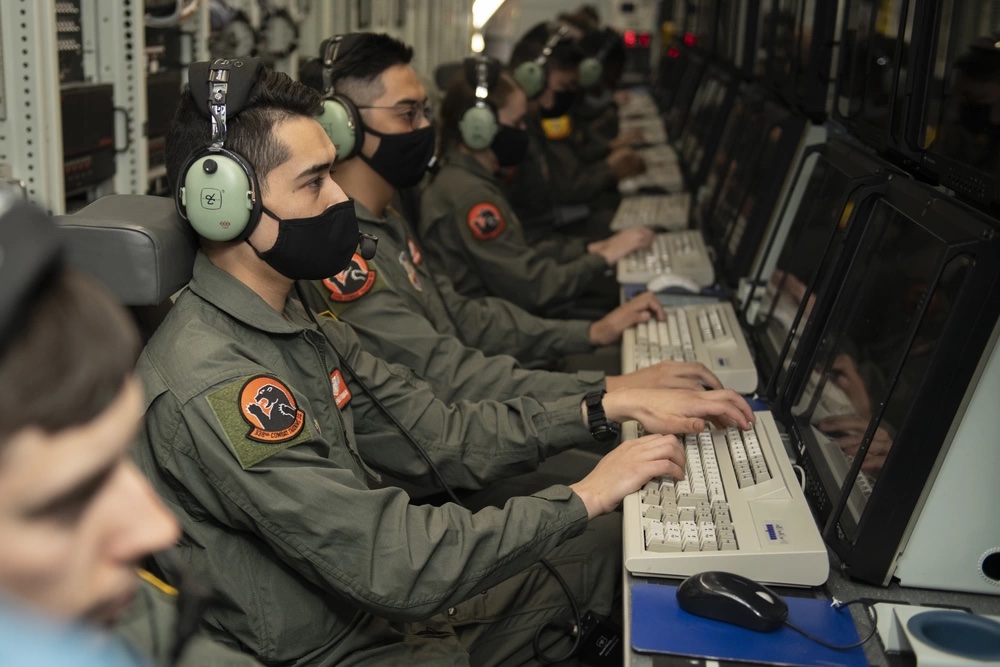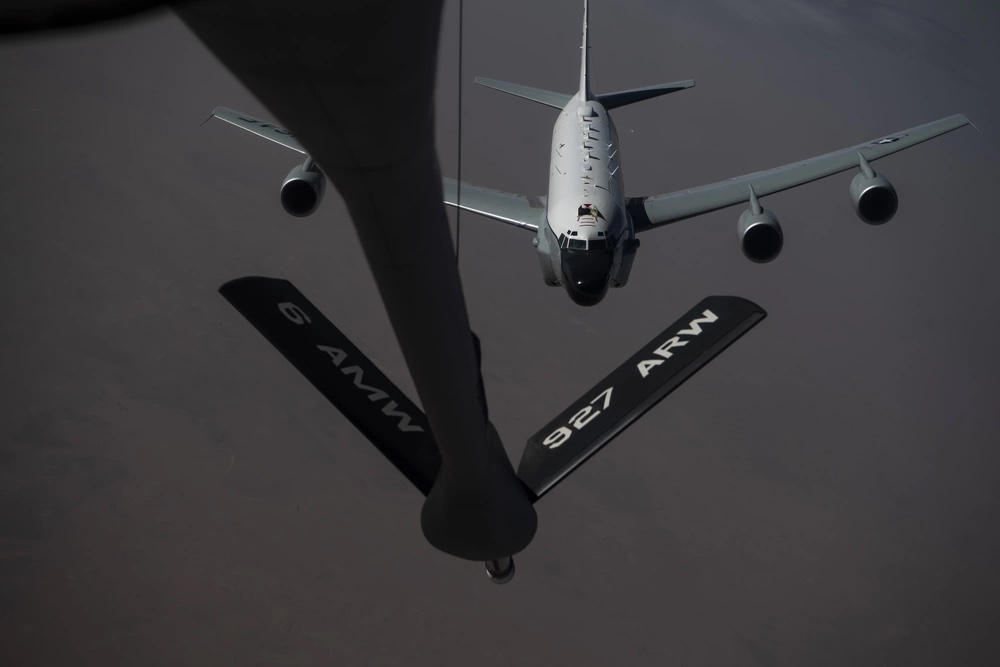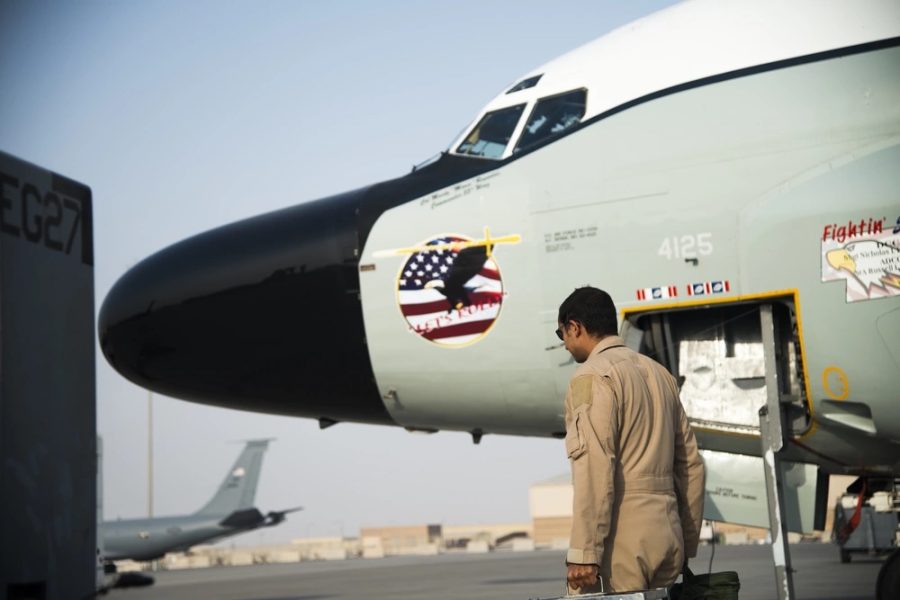OFFUTT Air Force Base, Neb.—Headquartered here in America’s heartland is the 55th Operations Group, which flies intelligence-gathering missions all over the world with a small fleet of 28 RC-135 aircraft.
“People might not fly a mission if an RJ [Rivet Joint] isn’t available, or the package is weakened because an RJ isn’t there to support it,” Lt. Col. Craig Lee, director of operations for the 338th Combat Training Squadron, a component of the 55th OG, told Air & Space Forces Magazine during a visit to Offutt in May.
“Same thing with large force exercises,” Lee added. “Our jet’s in such high demand and it’s because of what everyone knows we bring to the team as a whole.”
The Jets
The 55th Wing’s unofficial motto is “The sun never sets on the Fightin’ Fifty-Fifth,” which Airmen make true by flying global missions aboard these aircraft:
- 17 RC-135V/W Rivet Joints: Mobile listening posts, collecting real-time electronic and signals intelligence
- 3 RC-135S Cobra Balls: Study ballistic missile activity
- 2 RC-135U Combat Sent: Locate, identify, and analyze radar signals
- 3 WC-135R/W Constant Phoenix: Collect samples of the atmosphere to detect nuclear weapons testing
- 3 TC-135Ws: Serve as training aircraft
Most RC-135 jets are approaching 60 years in service. Hard-working maintainers keep the aircraft flying, while engineers rebuild the aircraft every few years to make way for cutting-edge electronics and intelligence-gathering equipment.
The Mission
Though Airmen at the 55th OG do critical work, much of it stays behind the scenes.
“We don’t immediately see the ramifications of our missions, like we don’t get instant gratification,” said Staff Sgt. Brandon Weik, an airborne systems engineer. “But I do enjoy turning on the news three months or six months later and seeing the impact of a mission I know I was on.”
The work often directly benefits fellow service members. When the Combat Sent collects information on radar signals, it can help Air Force fighters and bombers update their radar warning receivers. When the Rivet Joint detects new weapons systems or new capabilities, it helps the entire military be better prepared.
Sometimes the results are immediate. Lee often helped gather fresh intelligence for troops in contact while on deployments to the Middle East during the Global War on Terror.
“You might have spent six hours on station or on orbit and you’re ready to leave the country, but all of the sudden you get one of those calls over the radio and we need to support them,” he said. “It’s tough on crews because you’ve been out there a long time, but in that mission you’re there to help get that intel directly to troops on the ground.”
Each variant of the RC-135 requires unique skill sets. The Constant Phoenix, for example, requires at least two special equipment operators (SEOs) to run the subsystems that collect particulates from the outside air, which scientists analyze when the jets return to base. SEO Staff Sgt. Eric Martin is proud to be part of such a unique mission.
“Most people think of radiation and think ‘avoid it,’” Martin said. “With this jet we’re able to go and actually do that safely, which I think is really cool.”

Meanwhile, the Rivet Joint usually flies filled with electronic warfare officers, airborne system engineers, intelligence operators, airborne mission supervisors, and airborne signals analysts, not to mention the two pilots and a navigator in the cockpit. There are often about two dozen crew members, though it can vary by mission.
Each position aboard the Rivet Joint has its own computer station. Right behind the flight deck, three electronic warfare officers collect electronic intelligence, often from radars, surface-to-air missiles, or other systems. Further down the fuselage, three airborne systems engineers serve as an “airborne geek squad,” maintaining their crewmates’ high-tech equipment, said Weik. They also run the air conditioning units that cool the electronics, and they double as firefighters in case the cooling effort fails.
“If a fire were to break out, which luckily has never happened to me, we’re the ones who respond to it, shut down the electricity, get that fire isolated and then extinguished,” he said.
Taking up most of the cabin are more than a dozen intelligence operators who scan intercepted communications. Airborne analysts oversee their work and report to the airborne mission supervisor, while an information integration officer coordinates the effort with the rest of the battlespace and a data link operator helps share information between aircraft.
Rivet Joints frequently fly over vast and diverse areas, so the operators are often linguists who have trained for years and might specialize in technical fields or regional dialects, said one airborne analyst, Tech Sgt. Brittany Sizemore.
In the back of the Rivet Joint sits the airborne signals analyst, who picks up nonverbal communications, the ‘beeps and squeaks’, as one analyst, Tech Sgt. Thomas Frederick, put it.
“I feel like we’re the future of the RJ,” he said. Signals are always changing as more advanced communication technology comes online, “so our job is to process the ones we know and find the new and unusual stuff as well.”
The Galley
Frederick’s station at the back of the jet puts him close to the galley, which consists of two refrigerators, a convection oven, and a microwave. The galley is put to good use during a Rivet Joint mission, which can last 16 hours or more.
“People get really creative back here, especially on long sorties. They’ll make pulled pork or taco bars or pizzas,” Frederick said. “Cinnamon rolls are a big hit for some reason.”
Other menu options include croissant crust-pizza, sticky toffee pudding, muffins, chicken wings, cordon bleu, and easy-bake cookies, along with the usual snacks and energy drinks. One common challenge on the Rivet Joint is to eat 100 quarter-sized chicken nuggets in one sortie.
“It’s not something I want to do again,” Frederick recalled. “You don’t really feel great after that.”
It feels even worse to smell a fridge full of forgotten food after the jet has been sitting in the sun all day in a hot place like Al Udeid Air Base, Qatar, which is why RJ crews sweep out all food off the aircraft after a sortie.
“If you leave your food in there and someone catches it, you’ve got to buy them some kind of treat,” Frederick said.
Meanwhile, aboard the Constant Phoenix, Airmen try to perform 10 pull-ups an hour using straps dangling from the ceiling above the flight deck. The reps add up over a 15-hour flight, and some Airmen also do squats while microwaving food in the galley.
“You try to find healthy ways to keep your mind in the game,” said one Phoenix crew member.

The Flying
The crew positions are connected via an interphone panel, which crew members use to coordinate with each other and the flight deck to accomplish objectives.
“I try to distinguish what the back end wants, create a mission plan, and send it to the pilots so they can actually fly it,” said Capt. John Burns, a navigator. “It’s a lot of communication, and since we can all hear each other over the interphone panel, you get to know people very well, even if they don’t want you to.”
The flights themselves can get bumpy: the Combat Sent sometimes descends rapidly to capture data on adversary radar systems, while the Constant Phoenix plows through clouds and weather to collect atmosphere samples. One pilot, Capt. Taylor Pearce, called Combat Sent flying “the most dynamic, which makes it the most fun as a pilot.”
“That’s one of the coolest things about this community is that we’re all qualified on a different airplane, and they look and act much the same, but the flying that you do on them is actually significantly different,” he added. “So I’m never bored. You get to fly a whole bunch of different missions and you’re not doing the same thing all the time.”
Indeed, the 55th Operations Group is a medley of aircraft, specialists, and missions that share one thing in common: the intelligence they gather can save lives.
“Every position is critical to the overall mission of the jet, and we know there are people depending on us,” said Lee. “When everyone else is in trouble, when they’re in harm’s way, we’re the ones basically allowing them to know what’s out there, and we take that really seriously.”

